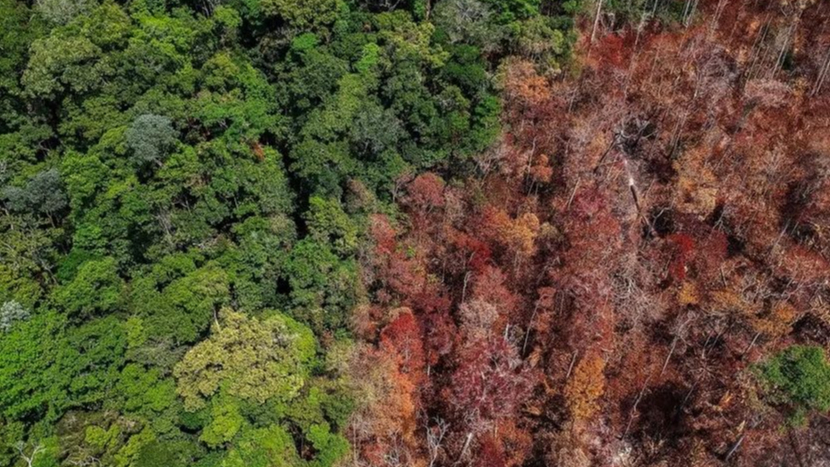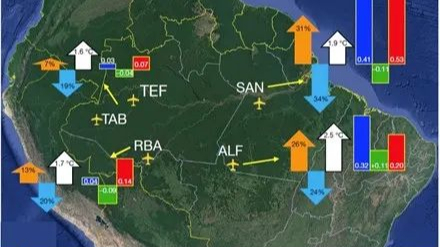Accelerating degradation of the Amazon rainforest: how the lungs of the earth are turning into carbon manufacturing plants

The Brazilian Amazon rainforest is the largest tropical rainforest on Earth, covering an area of about 7.2 million square kilometers, accounting for more than half of the world's tropical rainforests and storing one-fifth of the world's fresh water.
As a result, the Amazon rainforest is considered the "lungs of the planet". However, the "lungs of the earth" are suffering from a severe and unprecedented drought, and river levels are falling at an unimaginable rate.
The water level of the Negro River, the second largest tributary of the Amazon River, has dropped to 13.59 meters, well below the 17.6 meters it recorded in the same period last year, according to October 2023 data. This is the lowest water level since local hydrological records began in 1902.
Generally, the Amazon rainy season starts in October every year, but in 2023, the Amazon remains dry and hot until the end of November. According to scientists, the phenomenon will continue until at least the first half of 2024.
Costa, a plant ecologist from the Amazon Forest Research Institute, said that the 2015 drought was estimated to have killed 2.5 billion plants locally in the Amazon, and that the drought in 2023 was more severe than in 2015, with more than 2,700 fires caused by drought reported in October 2023 alone.
On one side, rainforest plants are dying in large numbers due to lack of water, and on the other side, animals are also dying in large numbers due to high temperatures. In September 2023, 150 puffer fish were found dead in Lake Tefe, where the water temperature reached 39°C. All this is destroying the Amazon's ecosystem.
It's not just a drought issue, but more importantly, the Amazon drought releases a lot of carbon. The former "lungs of the earth" have become the "culprits" of accelerating the climate crisis.
For the first time, scientists have confirmed that the Amazon rainforest now releases more carbon dioxide than it absorbs each year, according to a new study in the journal Nature. What is the reason for this transformation, and can humanity save the "lungs of the earth"?
01
The current drought in the Amazon is unprecedented
Recent decades have been the warmest in the observation period, with severe droughts in the Amazon in 2005, 2010, 2015/2016, lesser droughts in 2020 and very severe droughts in 2023-2024.
The current drought is the most extreme on record because it begins before the rainy season, whereas in previous events, the drought occurred at the peak of the rainy season (Southern Hemisphere summer).
Philippe Feinside, a professor at the Institute of Amazonian Research in Brazil, said the drought was caused by two interrelated factors.
1/El Niño: El Niño alters the precipitation pattern in South America, resulting in dry air in the north where the rainforest is located, and humid air in the south.
2/ Warming of the sea: Warming of certain waters due to climate change has affected the intertropical convergence zone. This area is one of the main meteorological systems in the tropics and is also an area where clouds and rain form. The region has shifted north, away from northern Brazil.
Together, these factors inhibit cloud formation, resulting in a drastic drop in rainfall. In the Amazon city of Belém, September 2023 received a quarter of the rainfall compared to September in previous years.
El Niño 2023 is expected to continue to evolve in the first half of 2024. For the world, this severe drought is a global crisis of humanitarian and ecological crisis.
One of the most striking effects is the high mortality of fish and aquatic mammals in the Amazon Solimões-Amazonas, images of leafless trees on the riparian banks, and fires in dry forests.
02
A huge source of greenhouse gas emissions
Few ecosystems on Earth are as important to the global climate as the Amazon rainforest.
It's no secret that the Amazon is home to huge carbon reserves. Trees alone store about 80 billion tonnes of carbon, and another 90 billion tonnes per square metre of soil.
However, scientists liken this to a latent bomb that could explode unintentionally, as droughts and forest fires could destroy these carbon stocks and release more carbon dioxide into the atmosphere.
Scientists say the huge canopy in tropical rainforests acts like an "air conditioner" for the planet, influencing global temperatures and rainfall patterns. Through photosynthesis, plants and trees in the Amazon absorb billions of tons of carbon dioxide from the air each year, which helps limit the amount of endothermic gases in the atmosphere.
But when it burns, the carbon stored in the forest is released into the air, where it can stay in the air for hundreds of years and contribute to global warming.
As far as the global climate is concerned, this could indeed be the straw that breaks the camel's back. As long as a small fraction of them enter the atmosphere within a few years, it is possible to push the climate past this tipping point.
However, research shows that carbon emissions in the Amazon region have changed. Scientists monitor data that the Amazon rainforest produces about 1.5 billion tonnes of CO2 per year, while the forest absorbs 500 million tonnes on its own, which means emitting 1 billion tonnes of CO2 into the atmosphere every year.
Researchers at Brazil's National Institute for Space Research (INS) say that rainforests now absorb about three times as much carbon dioxide as they receive, and in areas where the rate of forest degradation is above 30 percent, carbon dioxide emissions are already more than 10 times that of areas with forest degradation below 20 percent.

Source: Amazonia as a carbon source linked to deforestation and climate change
According to the study above, the eastern Amazon has become a pure carbon production plant, while the western Amazon, although relatively well forested, has only barely balanced out its own carbon dioxide production for various reasons.
Luciana vanni Gatti, a scientist at Brazil's National Institute for Space Research, said the drought in the Amazon was a "long-lasting disaster" and that worse could be to come.







